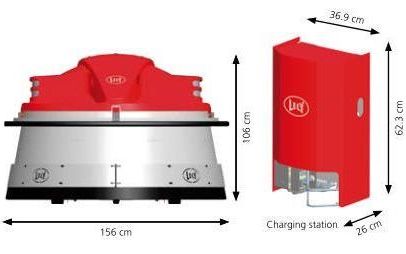Why a feed pusher?
It is well known that frequent feeding results in an increased feed intake and higher milk production. In addition, frequent feeding has a positive effect on the cow's health. However, labour is often a limiting factor in trying to provide cows with fresh feed 24 hours per day.
With the introduction of the Lely Juno feed pusher, Lely provides you with the ultimate solution. Based on the proven technique of the Lely Discovery mobile barn cleaner, the Lely Juno drives automatically over the feeding alley by following the feeding fence. It pushes the feed toward the fence as often as required without disturbing the cows. The Lely Juno is an easy to install, stand-alone machine which requires no additional facilities or modifications to your barn. This makes it suitable for almost all types of farms. The Lely Juno contributes to the welfare of your herd by stimulating the cows to approach the feeding fence more often. The cows have a better roughage intake and the herd is calmer and more tranquil. Low ranked animals will now also have sufficient access to fresh feed. The Lely Juno in combination with the Lely Astronaut robotic milking system shows a more consistent visiting behaviour to the robot day and night, resulting in even more efficient use of the Lely Astronaut. The Lely Juno feed pusher will save you a lot of valuable time and give you the flexibility and freedom to devote your energy to other tasks, knowing all the time that your cows are being taken care of in the best way possible.
Is it safe?
As the Lely Juno runs in the feeding alley, which is an easily accessible part of the barn, safety is of the utmost importance. A special feature has been designed on the feed pusher; the collision detector. This ensures the feed pusher stops immediately if it encounters an obstacle.
Benefits of the Lely Juno to you and your herd
- 24 hour operation - The constant availability of feed stimulates extra cow traffic, especially during the night when feed is not normally pushed to the fence.
- Increased Forage Intake - The Lely Juno stimulates the cows to approach the feeding fence most often resulting in a higher dry matter intake and less waste feed.
- Equal Quality Ratio Available Day or Night - With the Lely Juno, all feed is constantly pushed towards the feeding fence. This gives an equal mixture during the day and night.
- Cost Saving - Better intake means less waste forage. Saves labour as well as machines and fuel. The Lely Juno is equipped with an energy friendly electric motor.
- More Peace in the Herd - Due to the regular action of the Lely Juno, low ranking cows can also access fresh feed after the high ranking cows have eaten their ration.
- Labour Saving - Assuming a round takes only 10 minutes, the Lely Juno will save you at least 183 hours or in other words 22 (8-hour) working days annually!
What kind of setup do I need in my barn?
Feeding alley:
- Solid, level concrete floor
- Minimum of 200 cm width of feed area
- Limited slope
Location of charger
- The location of the charging base is variable, however it needs at least 3 m clear space for approach and at least 3 m clear space for approach and at least 1.5 m clear space for departure
- Barn must allow for possibility of installing a metal strip close to charging station (50 mm x 4 mm x 3,000 mm)
Feed distribution:
- Height - no more than 75 cm
- Width - less than 200 cm
Feeding fence types:
- A horizontal bar at a height of 65 to 115 cm (measured from the floor of the feeding alley)
- Vertical bars with maximum intervals of 80 cm
- Locking head, horizontal pipe, parallel, U type were tested

Specifications
- Weight (kg): 575
- Pushing blade height (cm): 60
- Driven by: electric motor (2)
- Wheels: 3
- Travel speed (m/min): 12
- Batteries: 1
- Voltage: 12
- Capacity (Ah): 55
- Determination of direction of motion: Gyroscope and ultrasound
- Determination of distance travelled: Sensors on rear wheels and an inductive sensor
- Number of programmable routes: 16
- Route programming: Using manual controlling unit (E-link)
- Direction calibration points: Metal strips start/end near charging station
- Maximum width of feed (cm): 200
- Maximum height of feed (cm): 75
- How often can a route be started?: Every 30 minutes
